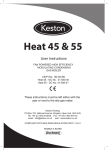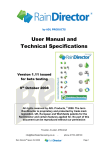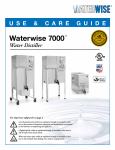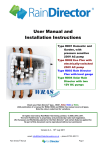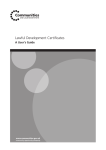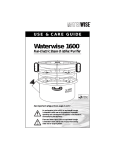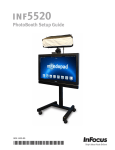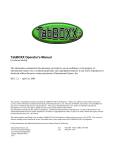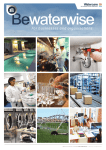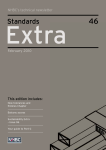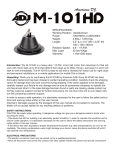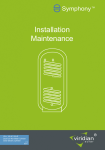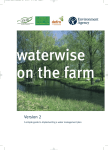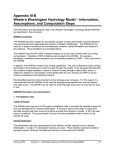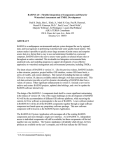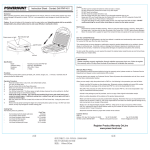Download Supplying WCs And Washing Machines
Transcript
Rainwater Harvesting: Supplying WCs and Washing Machines A white Paper from RainWaterHarvesting.co.uk Reducing water consumption, changing users’ behaviour, use of rainwater and water-efficient appliances. Even in the wet old UK, we have to reduce our consumption of water. There are three main ways we can do this: alter our behaviour so that we just use less water, use rainwater whenever mains quality water is not needed, and use water efficient appliances. WCs and washing machines represent 30 to 40% of our daily water consumption but they do not need mains quality water to operate. Other appliances – baths, showers, dishwashers, bidets and kitchen sink units – need drinking quality water. As WCs and washing machines are, therefore, destined to be the appliances supplied by rainwater, RainWaterHarvesting.co.uk has provided information to help choose models which not only will use rainwater but are also water efficient. NB. Much of the information provided here comes from Waterwise, which is a UK NGO focussed on decreasing water consumption and the leading authority on water efficiency. It is an independent, not for profit organisation that gets funding from the UK water industry, sponsorship and consultancy work. This paper includes some interpretation of, and comment on, the applicable regulations. As such, it should not be taken as authoritative. Any interested party should make their own research into the source material or take professional advice. RainWaterHarvesting.co.uk and the authors cannot be held responsible for the result of applying information in this paper without checking. rwh057 V2 9Oct09 wcs-and-washing-machines.pdf Rain Water Harvesting, Unit A Harrier Park, Southgate Way, Orton Southgate, Peterborough PE2 6YQ, United Kingdom Phone (+44) 1733 405100, fax (+44) 1733 230996, Email [email protected] Web site www.RainWaterHarvesting.co.uk 1 1. Washing Machines Washing machines used to use as much water per wash as a person now uses in an entire day - up to 150 litres. Advances in technology over the past 20 years, however, have succeeded in reducing the average water consumption to about 50 litres per wash still quite a bit of water! Clothes washing now accounts for about 14 percent of the water that we use on our homes, so by reducing wastage in this area we can make significant water savings. Rainwater can safely be used in washing machines, so you can reduce your overall mains water consumption by using rainwater and buying a water-efficient model. Washing machines vary tremendously in how much water they use per wash but the key factor to find out is the dry clothes load to water use ratio. To figure out the water efficiency of a clothes washing machine, simply divide the model’s water consumption (in litres per standard cycle) by its capacity (in kilograms). For example, a machine using 39 l for 6 kg is less efficient than one using 43 l for 7 kgs. You can find water consumption information on the EU Energy Label that is affixed to all models. The best models will have a water efficiency of less than 7.50 litres per kilogram, while the very worst can exceed 20 litres per kilogram. To meet the Code of Sustainable Homes levels and the new Building Regulations Part G, washing machine consumption must be calculated to this formula rather than overall consumption per load. For the full calculator see http://www.planningportal.gov.uk/uploads/br/water_efficiency_calculator.pdf For a list of the 9 most Water Efficient Washing Machines as provided by Waterwise, see: http://www.water-efficient-buildings.org.uk/wp-content/uploads4TQ/washing-machines.pdf For a full List of Washing Machines ranked by water use done by Waterwise in 2007, see: http://www.waterwise.org.uk/images/site/Research/2007%20washing%20machines%205%20pages. pdf With any model, total water consumption will depend on how you use the machine. In order to minimise water and energy waste, follow the quick tips below. Quick tips to reduce water wastage from clothes washing • When using your washing machine, make sure to use a full load every time. Surveys have shown that a typical load of laundry is 2 • • • usually much less than the maximum capacity of the model, so make sure to stuff in a couple of shirts with your next load. If you need to do a wash but don't have a full load, use the half load feature on your machine. Remember, though, that some half loads will use almost as much water as a full load, and that two half loads will use more water and energy than one full load. If you're purchasing a new machine, choose a model with a capacity that is appropriate for your situation. If you live alone, you're most likely to not need a model that can wash 10kgs of clothing. Familiarise yourself with your washing machine’s cycle options. Some settings provide the same cleaning power as a normal cycle, but with less water and energy. Check your user manual for water consumption information about the various cycles on your model, or contact the manufacturer. Avoid pre-washing. Most modern washing machines and washing powders are so effective that you don’t have to pre-rinse! Water Pressure Some modern washing machines require a higher pressure of water than older machines. Manufacturers’ specs often state 1 to 1.5 bar. This is because the washing machine’s controller measures the time taken for the water to fill the washing machine and times out if it is not fast enough. Rainwater harvesting systems can provide either a direct or indirect supply from the main storage tank to the appliances. In a direct system the pump sends the rainwater on demand straight to the appliance. In an indirect system, the rainwater is pumped up to a rainwater header tank, where it is gravity-fed to where it is needed. The advantage of an indirect system such as RainWaterHarvesting.co.uk’s RainDirector® is that pump wear and tear is reduced and 8 to 10 times less electrical power is used because the pump is activated only when the header tank is empty rather than every time an appliance is used. To ensure sufficient pressure in an indirect system, manufacturers, e.g. Miele, Electrolux, AEG, Zanussi and Tricity, recommend that the header tank is at least 16.5 feet (5 metres) above the washing machine. If you cannot get the header tank as high as that, fit up the piping and see if the washing machine works satisfactorily. If not, here are some remedies. 1) Ensure the piping from the header tank to the washing machine is as wide as possible and has no constrictions at the joins. 2) Have the pressure-reducing spiral at the water input of the washing machine removed (n.b. check whether this invalidates your washing machine guarantee) 3) Failing which, fit a pressure sensitive booster pump at the rain output of the header tank or before the water input of the washing machine. However, most machines work with 0.5 bar or less so the problem should not arise. 3 2. WCs WCs made before 1991 used around 10 litres per flush but since 2001, the Water Fittings Regulations have stipulated that the maximum flush volume is 6 litres per flush. Many models are now around the 4.5 litre flush when they are eligible for the Water Efficiency Label (WEL see below). Where WCs are designed to allow different flush volumes, the lesser flush should not be more than two thirds of the full flush. The official Water Calculator assumes that WCs are used 4.42 times per person per day and for dual flush WCs the ratio of use for the different flush volumes will be shared between them 33% for full flush and 67% for half flush. Traditionally, WCs have relied on a siphonic flush valve to control the flush and this is still common in single flush WCs. Newer style dual flush WCs rely on a more complicated drop valve mechanism to control the flushes. The main driver for introduction of valve WCs is that drop valves provide better control at low flush volumes. However, an emerging problem is that drop valve mechanisms are susceptible to debris and biofilm build-up causing the seals to leak, wasting around 500 litres of water a day, which can remain undetected for long periods of time. It is better, therefore, to choose a siphon-activated WC: they rarely leak. Most, if not all of the siphon-controlled WCs on the market are made in the UK. The flushing mechanism of some WCs is pressure dependent. Check that the WC manufacturer’s requirements can be met particularly if you are using gravity feed or live in a low pressure. WCs are either available as ‘close coupled’ with the pan matched to the cistern or with pans and cisterns as separate items that are paired to meet the performance requirements of the Regulators Specification in the Water Fittings Regulations, which is based on BS EN997. When sold separately to the cistern, pans are available as ‘wall hung’ or ‘back to wall’ When matching WC pans with cisterns, particularly those that have variable operational flush volumes, it is very important to ensure that the pan has been paired and the correct operational flush volume has been selected for the cistern. The Bathroom Manufacturers Assocation (BMA) maintains a list of WCs that have been awarded its Water Efficiency Label (WEL). Products eligible for this label are “WCs complying with Class 2 of EN 997, when flushed with the Volume(s) claimed - provided the flush does not exceed 4.5 litres per single flush, or in the case of dual flush mechanisms, by an average flush not exceeding 4.5 litres - based upon a ratio of 3 short flushes to 1 full flush.” Click here for a web link to the Table of Water Efficient WCs In the table above, products are listed with flush volumes smaller than the regulatory maximum, although it is possible to reach a specification of 120 or even 105 litres per head per day with standard 6 litre /4 litre flush WCs. 4 Retrofitting properties WCs installed prior to 2001 will usually have larger flush volumes than the current regulatory maximum of 6 l. The amount of water consumed by these WCs can be reduced by retrofit flush volume reduction devices. These range from simple displacement devices such as the ‘Hippo’ to sophisticated devices that are fitted to the flush mechanism of siphon WCs to provide dual flush capability. For a selection of these products click on this web link: Table of WC Retrofit Devices Please note that these WC flush reduction devices should not be retrofitted to WCs installed since 2001 or to WCs that have a dual flush mechanism. Also note that retrofit dual flush devices can only be retrofitted to WCs with a siphon mechanism, but in the UK this includes most pre-2001 WCs. WC Bowl Discolouration Sometimes people worry that using rainwater will discolour the ceramic of WC bowls. This should not happen because as it is recommended to store rainwater in underground tanks, it remains fresh (bacterial activity is suppressed below 12-15°C). It is also sufficiently filtered before entry into the tank to remove sediment and debris. If an indirect system is chosen whereby rainwater is pumped to a header tank and then gravity feeds the appliances, it is possible the rainwater could discolour if the roof space gets very hot and there is no turnover in the tank during, for example, a summer holiday. RainWaterHarvesting.co.uk has developed the RainDirector® which caters for this eventuality. Besides its other functions, it has a holiday setting whereby the rainwater is changed every 2 or 3 days in the header tank to ensure no stale water in the system, whether or not the user presses the “holiday” button. For further details download the manual by clicking on this web link: www.rainwaterharvesting.co.uk/downloads/rain_director_brochure.pdf Susan A. Bicknell M.A. Senior Researcher, RainWaterHarvesting.co.uk. email: [email protected] August 2009 RainWater Harvesting Limited, Unit A, Harrier Park, Southgate Way, Orton Southgate, Peterborough PE2 6YQ Phone 01733 405100 - Fax 01733 230996 Email [email protected] - web site www.RainWaterHarvesting.co.uk Registered office: Rutland House, Minerva Business Park, Lynch Wood, Peterborough PE2 6PZ Company No. 03967275 - VAT No. GB 940 8955 90 5





